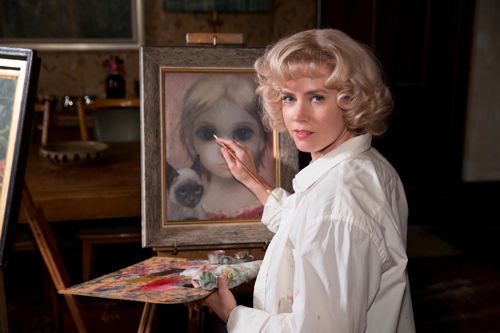
You’ve all seen the paintings—on some paneled den wall, on post cards, on ashtrays: the sad little urchins, often clutching a puppy or kitten, with their ridiculously large, searching eyes. The paintings have come to represent the apotheosis of kitsch—a mass produced mixture of bad taste and sentimentality masquerading as art. But thanks to Tim Burton’s Big Eyes, you’re about to discover the totally nuts true story behind the paintings.
In the 1950s— long before it was fashionable, as the film points out—a woman named Margaret (Amy Adams) left her husband, took her young daughter, and moved to San Francisco, where she attempted to peddle her paintings of moon-eyed children on the street. That was when she met Walter Keane (Christoph Waltz), a fellow painter, whose Parisian streetscapes sold for a much higher price than her urchins. Walter seduced Margaret, while emphasizing the importance of never underselling one’s work. They were soon married.
It was some combination of genuine misunderstanding and jealousy that led to Walter taking credit for Margaret’s paintings himself. At first she resisted, but the wheels were already in motion. The paintings were selling, with the charming—if hot-tempered—Walter Keane as their artist. To admit the truth now, Walter pointed out, would make Margaret an accomplice in their fraud.
Somehow, remarkably, Margaret and Walter went on like this for years—not even telling Margaret’s increasingly suspicious daughter or her best friend (Kristen Ritter) the truth. With Walter’s genius for salesmanship—getting the paintings in the hands of celebrities, mass distributing reproductions—the big-eyed urchins became the most popular art objects in the world. He did, indeed, anticipate Warhol—creating the artist as celebrity and the art itself as commodity. And all the while, it was Margaret who did the work, toiling in the shadows.
I think the thing I like best about Big Eyes is Burton’s generosity toward Margaret. He seems to genuinely respect her as an artist—she was indeed skilled as an illustrator and obviously tapped into something that moved people. He also has some fun creating an eyeball obsessed universe, filled with peepholes and funhouse mirrors and haunting scenes where everyone Margaret encounters has “big eyes.” Most importantly, he’s able whip us into a spirit of genuine indignation on Margaret’s behalf—we root for her like she’s the Rocky of kitsch.
It helps that Adams—who always manages to convey multitudes beneath her own wide-eyed appearance—is brilliant here. We believe in her as both someone impressionable enough to get bamboozled and strong enough to reclaim what’s rightfully hers.
Waltz, however, is slightly problematic. He’s convincing as the genius hustler and huckster. Ditto on the scenes where he shows Walter’s frightening temper. He’s a bit less convincing, though, as a seducer. He’s so manic, so weird, it’s hard to believe Margaret would’ve ever fallen for him in the first place. He just might be playing the character too broadly. Ironic since this is one of Burton’s most naturalistic films ever.
Lately, I had grown weary of Burton’s over-stuffed Johnny Depp freak shows. Big Eyes confirms that Tim Burton’s imagination and eye—his keen sense of visual humor (note a scene where one of Margaret’s paintings is lowered into a crate)— is rich enough, he doesn’t need to force-feed the whimsy. He just needs to tell a great story.
